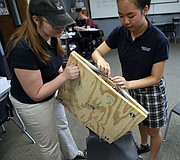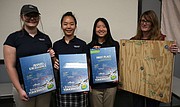Bulletproof friends
HAYDEN — How can we protect students during school shootings? A team of North Idaho Christian School students tackled that question, and won first place in the multi-approach category of the McKinstry Built Environment Challenge at Imagine Tomorrow last weekend.
The competition held at Washington State University in Pullman, Wash., was sponsored by Alaska Airlines and focused high school students across the Northwest on sustainability problems. The NICS team, comprised of sophomores Jennika Bettis, Anna Cho, and Cathy Ko, used old mud flaps, playground rubber chips and plywood to build a bullet-resistant school teacher’s desk.
The idea for a bullet-resistant desk came thanks to a spike in school shootings in the U.S., Cho said.
“We really felt a need to invent something for school shootings,” said the exchange student from Bundang, South Korea.
Ko, who is also an exchange student and hails from Seoul, South Korea, pointed out that other students have designed devices to protect students during active shooter situations. Idaho native Bettis explained that the teacher’s desk would have accordion-like wings that could extend to serve as a barricade big enough to shield 20 or more students from incoming rounds.
Since the Imagine Tomorrow competition required students to use recycled or recyclable materials, the students used old mud flaps Bettis’s family had around, said NICS science teacher Kiera Beck. With the help of some donated plywood and some elbow grease, the girls had something to test on a nearby range. Bettis’s brother, Nathan Ferguson, was instrumental in actually building the prototype and helping the girls learn how to shoot guns in order to test its effectiveness.
Cho explained that the students used plywood and rubber “because rubber can absorb the kinetic energy of a bullet.” They’re interested in using old tires as a source of rubber for the desks.
The girls built two small sections of the desk and shot them each with .22, .380, .40, and 9 mm ammunition. They found that the model built out of three mud flaps and two one-half inch pieces of plywood stopped .22 and .380 rounds, but not 9 mm rounds.
A second model built with playground rubber chips in place of the mud flaps was less effective, stopping .22 rounds only, but not withstanding the impact of larger caliber ammunition. Ko said judges at the event, and family members here, advised the students that they need to add space between the rubber layers.
“The rubber needs to be able to give more than it did,” Bettis said.
Cho said the students hope to improve their design and make it work. School shooters tend to use 9mm ammunition, she said, so the students want to make sure their design can stop bullets at least that large. A Seattle police officer at the event told the girls that even slowing down the rounds is good, Bettis said.
Beck pointed out that the students did this for fun, and not for class or grades or extra credit. After coming up with the idea last fall, in January they began meeting weekly for an hour to work on the project together. In addition, the students toiled away on their own time, she said.
The students thanked Beck and Bettis’s relatives, who explained guns to them. Cho thanked the companies who sponsored the competition, calling it “an investment in future generations.”
Cho and Ko are in their second year at NICS and were part of a team that won second place at last year’s Imagine Tomorrow competition. They recruited Bettis to take part this year. Beck explained that because Alaska Airlines has decided it will no longer sponsor the event, this was its last year. However, Cho and her teammates are eager to continue to refine their design, patent it, and bring their idea to fruition.
Innovation Collective founder Nick Smoot was the keynote speaker at this year’s Imagine Tomorrow. In keeping with the theme of the local hub, the NICS students said they’re keen to collaborate with local experts who can help them turn their idea into a solution for schools here. Redesigning may slow down for the summer when Ko and Cho return temporarily to South Korea, but they’ll be back at NICS next fall.
“With all the people dying we wanted to do something to help them,” Bettis said.









